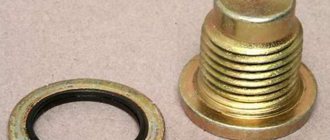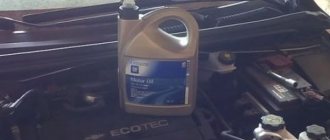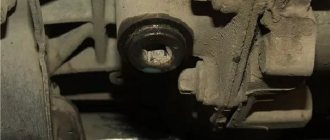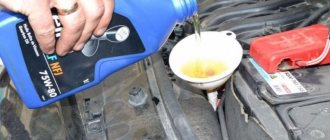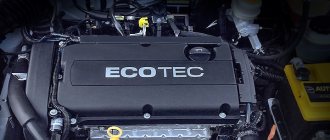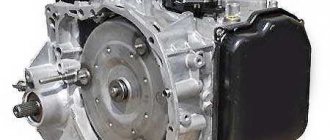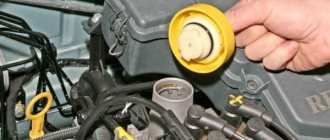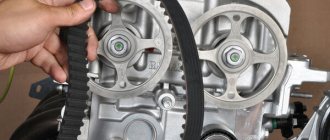What happens to the car if the filter is clogged?
Untimely replacement of the oil filter on Logan can significantly affect the operation of the oil system and the engine in particular.
Chips from friction of the surfaces of parts, dirt and dust from routes - all this passes through filtration along with the engine oil and enters the engine. The operating period of oil filtration is one year. The manufacturer recommends changing consumables every 15-20 thousand kilometers or once every 12 months. At the same time, once every six months you should look into the system and check the condition of the spare part. It is not always possible to follow the manufacturer's instructions - the operation of the filter is influenced by many factors that significantly reduce its service life.
Signs of a clogged filtration:
- fuel consumption increased;
- the car stalls and moves jerkily on inclines;
- engine power and thrust decreases;
- oil leakage, which leads to clogging of the element;
- slipping at idle;
- uncontrolled braking of a vehicle;
- difficult to start the engine the first time;
- the dynamic characteristics of the engine are reduced.
If you change the filter in a timely manner, as it wears out, you can prevent unwanted global repairs, which are ten times more expensive than the corresponding replacement process. By choosing a high-quality spare part, you can ensure uninterrupted cleaning of the engine fluid from decay products and dirt for a certain service life of both the engine oil itself and the filter device.
The most important failure of a part is damage to the housing or filter cassette. If the cassette is easy to replace, you just need to buy a new one and carry out repairs, but the body itself is difficult to change - due to its inconvenient location, a thorough repair will be required. If you strictly follow the recommendations described in this article, you can easily cope with replacing the oil filter on a Renault Logan alone.
Renault Logan oil change - alternative suppliers
As you know, the brand on the packaging of technical fluid is not the most important selection criterion. The main thing is to comply with the viscosity requirements (in our case SAE 5W-30 or SAE 5W-40) and the ACEA specification for European manufacturers.
- for all types of Renault Logan engines, an ACEA class of at least A3/B3 is required (regardless of diesel or gasoline power unit);
- power plants operating on liquefied gas (the French manufacturer also produces these) are filled with A5/B5 oil.
Of course, we don’t forget about the company’s factory approval. The cars in question require a Renault-Nissan RN 0700/RN 0710 certificate.
List of oils suitable for replacement:
ZIC X9 5W-30(40) pure synthetics, produced for European cars;
A little secret that French marketers hide:
Few people know that the Elf trademark belongs to the powerful Total concern. For marketing reasons, the products are divided into several brands, the most famous being Total and Elf. Since all motor oils are bottled in different cans at the same factories, you can buy the same consumables at different prices.
For example:
They even have the same canisters, only the plastic is a different color. Using the comparative tables of specifications and tolerances, you can easily select an analogue. Don’t let the difference in price bother you, the contents in the container are absolutely the same.
It is more difficult to find suitable oil among North American manufacturers; apparently they are not so interested in the European market. Nevertheless, changing the oil in a Logan engine will not cause problems with the selection of consumables. Of course, along with the lubricants, the filter element should also be replaced.
Analogs
Oils differ in parameters such as composition, type and properties. Among the analogues, you can consider the following options:
- Motul X-cess 8100 5W-40;
- Motul 8100 EcoEnergy 5W-30;
- Castrol Magnatec A5 5W-30;
- Castrol Edge Professional A5 5W-30.
Lubricants of these brands are quite suitable for changing oil in Renault Logan with the K9K . It is better to choose a viscosity of 5W40. They are recommended to be poured into engines with a displacement of 1.2, 1.4, 1.5 and 1.6 liters . The number of valves does not in any way affect the type of lubricant used: The oils will be identical for both eight-valve and sixteen-valve engines, but, as mentioned above, this only affects the amount that the engine needs.
Changing the engine oil and oil filter
Let's look at the recommendations for changing the oil that the manufacturer gives: Engine oil needs to be changed once a year, or every 15 thousand km. mileage (whichever comes first). Renault recommends (during the warranty period) the use of ELF brand oils (Elf Evolution SXR 5W30, Elf Excellium LDX 5W40, Elf Competition ST 10W40).
When choosing another oil, it must meet quality standards according to API SJ, SL, SM, viscosity depends on climatic conditions - 15W40, 10W40, 5W40, 15W50, 5W50. If the car is used in difficult and dusty conditions, then the oil should be changed more often, after about 7-8 thousand mileage. The amount of oil in the engine (with filter) is approximately 3.3 liters.
We change the oil on a preheated engine; this is necessary so that the heated and therefore diluted oil is completely drained from the engine. First, unscrew the oil filler cap; this is necessary so that when draining the oil, a vacuum does not form in the engine, which would prevent the old oil from draining. After this, being under the car, we clean the area of the oil sump drain plug from dirt.
After that, placing a container (at least 4 liters) to drain the used oil, unscrew the drain plug with a square “10” wrench. It is good if the container for draining is wide so that the oil does not spill past... Be careful, as the oil is hot!
Wait until the waste has completely drained. At this time, you can inspect the oil plug and its washer, which has a thin rubber layer (see figure). If the washer is severely deformed or its rubber layer is damaged, then replace it with a new one. If you don’t have such a washer, you can use a regular copper one. After at least 10 minutes have passed since the start of draining the oil, screw the plug into place.
Now we change the oil filter.
Oil filter location
First, we try to unscrew it with our hands (counterclockwise). If this does not work, you will need a special oil filter puller. You can also do without a puller by punching through the filter with a large screwdriver and using this lever to move the filter from its place. To do this, you may have to remove the thermal shield so that it does not interfere by unscrewing the three screws with a “10” key.
When unscrewing the filter, keep in mind that oil will also flow out of it. By unscrewing the filter, we clean its place from dirt and stains. Fill the new filter with clean oil (halfway) and lubricate the rubber o-ring of the filter with a thin layer of oil.
And we wrap the filter with our hands until the rubber ring of the filter and the cylinder block come into contact, after which we turn it about 3/4 of a turn, without using any tools. Install the thermal protective cover if it was removed. Now we fill the engine with up to 3.3 liters. pure oil
We tighten the filler cap, start the engine for a few minutes, and the oil pressure warning light should go out a few seconds after starting. We inspect the engine from both the filter side and the plug side for oil leaks.
2163-13-05-01
We stop the engine. After a few minutes (so that the oil has time to drain into the oil pan), we check the oil level and bring it to normal. If necessary, tighten the oil filter and drain plug.
[Changing the oil in a 16-valve engine and the oil filter of Renault Logan/Sandero] [How to save up to 6,500 rubles on Renault Logan/Sandero maintenance] [Maintenance of Renault Logan/Sandero for 15 thousand kilometers] [Maintenance of Renault Logan/Sandero for 60 thousand kilometers] [Maintenance of Renault Logan/Sandero at 90 thousand kilometers] [Independent maintenance - general recommendations] [Safety rules for performing car maintenance yourself] [Tools required for carrying out maintenance of Renault Logan/Sandero ]
Changing the oil in an 8-valve engine and the oil filter in Renault Logan/Sandero
Changing the oil and oil filter for Renault Logan 2
Engine 1.6 8V (K7M) 1. Place the car on an inspection ditch or overpass. 2. Unscrew the oil filler cap.
3. Use an 8 mm square wrench to loosen the drain plug.
4. Place a container for used oil under the engine, unscrew the plug and drain the oil from the engine into the container.
5. Loosen the oil filter using a puller from the top of the engine compartment.
6. Unscrew the oil filter by hand and remove it.
7. Using a clean rag, carefully clean the landing surface of the oil filter on the cylinder block. 8. After the oil stops flowing out, screw the plug into the drain hole, replacing the washer if necessary. 9. Apply clean engine oil to the rubber o-ring of the filter. 10.
Currently reading: Replacing the Renault Logan ignition switch: contact group, Logan module
We screw the filter into place until its sealing ring comes into contact with the mating plane of the cylinder block. From this position, tighten the filter 1/2 -3/4 turns. 11. Install a funnel in the filler neck and pour engine oil into the engine crankcase, monitoring its quantity using the oil level indicator. 12.
Install the cap on the oil filler neck. 13. Start the engine and make sure that the emergency oil pressure indicator lamp has gone out. and there are no oil leaks from under the oil filter O-ring and from under the drain plug. 14.
Engine 1.6 16V (K4M) 1. Place the car on an inspection ditch or overpass. 2. Unscrew the oil filler cap.
3. Remove the engine crankcase protection (see here).
4. Use an 8 mm square wrench to loosen the drain plug.
5. Place a container for used oil under the engine, unscrew the plug and drain the oil from the engine into the container. 6. From the bottom of the engine compartment, use a puller to loosen the oil filter.
7. Unscrew the oil filter by hand and remove it. 8. Using a clean rag, carefully clean the flattened surface of the oil filter on the cylinder block. 9. After the oil stops flowing out, screw the plug into the drain hole with a new washer 10. Apply clean engine oil to the rubber o-ring of the filter (see above). eleven.
13. Install the oil filler cap. 14. Start the engine and make sure that the emergency oil pressure indicator lamp has gone out (it may stay on a little longer than usual), and there are no oil leaks from under the oil filter O-ring or from under the drain plug. 15.
The instructions are intended for Renault Logan 2021, 2020, 2021, 2021, 2021 models.
2163-13-05a-02
To prevent oil leakage from the crankcase pan, a thin layer of oil-resistant rubber is vulcanized along the surface of the washer hole.
Let's examine the puck. To prevent oil leakage from the crankcase pan, a thin layer of oil-resistant rubber is vulcanized along the surface of the washer hole. If the rubber seal of the washer is damaged, replace the washer with a new one. Drain the oil for at least 10 minutes. We wrap and tighten the drain plug. We remove oil leaks from the engine oil pan and the power unit protection.
When changing the oil, the oil filter must be replaced.
Place a container under the oil filter. Unscrew (counterclockwise) the oil filter. If this cannot be done manually, loosen the filter with a puller.
Renault Logan oil change
Let's consider 8-valve engines for 1.4 and 1.6l engines. Before replacing the oil filter on Renault Logan, you need to purchase a new original filter for this type of engine. Pay attention to the rubber seal and the serviceability of the bypass valve.
If the filter suddenly becomes clogged, the bypass valve will direct the oil flow bypassing the filter element. The oil will still flow to the engine bearings and the engine will not seize. The housing has a surface at the bottom for gripping with a special puller key.
Prepare materials and tools. • Special key remover. • Special 8 mm square wrench. • Rags or paper towels. • Engine oil. • Oil filter. • Drain container. Let's start replacing. It is necessary to warm up the engine so that the oil warms up and drains almost completely.
Place the car over the inspection hole or drive it onto a repair overpass. You can simply place the car on a flat surface and lift the front with a jack and secure it. You can unscrew the drain plug on the engine pan through the technological hole in the protective casing.
After the oil has poured into the prepared container, screw in the stopper. Pay attention to the pressure washer with a rubber seal; it seals the drain hole. It seemed like a small thing, but if the plug didn’t hold, a leak would appear. Advice: change the washer every time you change the oil - it costs pennies.
That's it, screw the plug in, change the filter. It is easy to access and replace if you remove the engine protective cover. It is located under the hood at the front. You don’t have to remove it if you have a special key, but for those who are doing this work for the first time, remove it. You need to unscrew the three nuts by 10 mm and then it will be easy and simple to get to the filter (white arrow).
Now, use a special key to loosen the connection, then manually unscrew the filter. This special wrench is universal and fits almost any oil filter housing and not only Renault. We change the filter, manually screw it in until it stops, then tighten it with a wrench without using excessive force.
Fill in original oil. First, 4 liters, then, after running the engine for some time, add it so that the oil level on the dipstick is just below the max mark.
After some driving, check all the connections that you took apart. Make sure everything is in place and sealed. For Renault Logan dCi 1.5 and 1.6 16V, replacing the filter is somewhat more complicated. It is necessary to remove the lower engine protection - 6 bolts, then drain the used oil and replace it as described above. The oil filter can also be replaced from below using a special wrench. This is where this filter is located (red arrow for Renault Logan 1.6 16V). Lateral placement of the filter.
For RenoDacia logandCi 1.5 2005 - the oil filter is located approximately the same as in the 1.6 16V, but the filter is located vertically, and even stands upside down.
It is easy to replace such a filter: unfasten it with a special key (you can use a universal one), unscrew it manually, install a new original filter and secure it with the key. Fill the dCi 1.5 engine with original oil: for diesel according to Euro specifications (ACEA)
Replacement on an engine with 8 valves
Instructions for changing oil for engines with 8 and 16 valves are slightly different. We will talk about the difference in the next subsection. Now let's find out how to change the engine oil and filter:
- Start the car and warm up the engine to 45-50 degrees Celsius. This will make the oil more fluid, making it easier to drain.
- Park the car over the hole or use a jack to raise the front end. Apply the handbrake and disconnect the battery by removing the negative terminal.
- Unscrew the oil filler plug in the engine compartment.
- There will be a drain hole in the crankcase area. Place a container under it and unscrew the lid with a special key. Don't lose the O-ring.
- While the oil is draining into the container, use a special puller to remove the old filter element. It is located at the front near the exhaust manifold. Clean the seat from dirt and old grease, and if necessary, replace the gasket with a new one. Fill the filter halfway with new oil and install it in place.
- Once all the oil has been drained, tighten the drain hole. Fill the filler neck with the minimum required volume of fluid for your specific engine. Check the level with a dipstick and add if necessary.
- Run the engine for 10 minutes and turn it off. Carry out a control measurement with a feeler gauge. The level should be between the Min and Max marks.
All work will take you 1-1.5 hours. The main thing is that the oil level is not below the minimum and not above the maximum.
How to change engine oil in Logan
To change the lubricant in the Renault Logan 2 engine, first take a short trip. This warms up the working fluid and makes it easier to drain. On the other hand, with this approach, care must be taken to avoid burns from contact with hot lubricant.
When changing the oil, proceed as follows:
- Discard the negative terminal from the battery. Here you will need a flat ten key. Use it to loosen the nut, then remove the terminal.
- Next, drive the car into the pit and cover part of the body with a cloth.
- Unscrew the plug through which oil is poured into the engine.
- Unscrew the plug to drain the lubricant from the Renault Logan 2 engine. Here you need to proceed as follows. First make 1-2 turns with the key, then tighten the plug manually. Place the empty container first to prevent the working fluid from getting on the ground. When performing this work, be careful not to lose the washer on the plug.
- Remove the crankcase guard if you need to change the filter on a 16-valve engine. After this, unscrew the six bolts around the perimeter. Use the “ten” key for these purposes.
- Bring the puller to the Renault Logan 2 filter housing, and then dismantle the part. If the work is done on an engine with eight valves, then the puller must be brought from above.
- Screw in the new filter by hand and then secure it using a puller. First fill the cavity with clean oil.
- Replace the plug for draining the working fluid, tighten it and return it to its place. Install crankcase protection.
- Fill in new lubricant through the special neck. For these purposes, use a funnel, which can be made from a plastic bottle.
- Wipe off any traces of old oil.
This completes the oil change in the Logan car engine.
Getting ready for replacement
Sooner or later, the driver is faced with the problem of changing engine oil. This action can be performed not only in a specialized service, but also at home. To do this, you need to carefully study the step-by-step instructions and buy the necessary tools. The first oil change in a Renault Logan engine is performed after 3,000 kilometers.
If you are a little late with this deadline, or do everything a little earlier, then it’s okay. Nothing will change from this. Changing the oil yourself requires a little experience and a few tools.
The frequency of oil changes in Renault Sandero and Duster varies depending on the type of power unit. If you have a gasoline engine, then the mileage is 15 thousand kilometers, and if you have a diesel engine, then 10 thousand kilometers. During this time, the engine will run-in and a small amount of chips will collect.
What kind of oil to pour
Many drivers have a reasonable question that should not be left unanswered. The fact is that the duration of operation of the power unit will depend on the quality of the motor fluid.
Modern experts recommend classic motor oil from ELF Evolution. It has good lubricating and cooling properties. It can be used in any weather conditions and in any region.
Engine oil volume
The standard configuration of Renault Sandero and Logan holds about three liters of high-quality oil. In Renault Duster from 4.5–5.4 liters. depending on the type of motor.
This will be enough to lubricate all the mechanisms and parts of the car, as well as to cool them in a timely manner. It is worth noting that the volume may vary depending on the configuration and cost of the vehicle. You can find this information in the vehicle's operating instructions.
Where to pour
Many drivers face some difficulty when it comes to filling oil. The fact is that not everyone knows the structure of a car well.
If this is your first time changing engine oil, be sure to look at the instructions below. It should be poured into a special neck, which is located under the hood of the vehicle.
How to unscrew it if it's stuck
I’ll tell you a few ways that will 100% help you unscrew this element, so here we go:
Trite with your hands. Often you just don’t have enough strength, just call a “more powerful” person and everything can work out. I will say this in 80% of cases they unscrew it by hand. YES, and you need to tighten it again with your hands, tightly! IT'S ENOUGH!
Special key. I already wrote about it once, you can, of course, it’s not always at hand, but if you have a friend with a car, he can drive to almost any spare parts store and buy it. I personally even saw it in several supermarkets, the cost is a penny, about 200 - 300 rubles.
Rope and screwdriver (another lever). Sometimes they also use an old alternator or timing belt. What we do is twist a loop around the filter, tighten it with a screwdriver, tightly. And we try to unscrew it. The main thing is that the rope or belt does not slip.
Currently reading: Get a Renault Logan serviced in Moscow: the cost of maintenance, the cost of Renault Logan maintenance at
Next come barbaric but effective methods. The most important thing is that they are dirty, that is, you will get dirty in oil anyway, if you are not afraid, then they are for you.
A hammer and a long, strong screwdriver. Actually, this method is used to unscrew most intractable filter elements. Since the walls of the element are soft, they are usually aluminum, or tin, and other soft metals. It breaks through very easily (just like a tin can)
What we do is drive a long and strong screwdriver all the way through, that is, so that it goes in on one side and comes out on the other. And then we unscrew it like a lever. The most important thing is that everything can be done without a special key, and actually using the tools that are always in the garage. The only downside is that your hands are dirty, because some of the oil is always inside.
Hammer and chisel. This is generally the method that they say “ATAS”, there is nothing to explain here, we take a chisel and “fuck” it with a hammer, the most important thing is to hit closer to the bottom, to the place of fastening, and counterclockwise. The case, of course, will be all dented, but the most important thing is to unscrew it.
As you can see, there is nothing complicated, you can do without a special key, just pierce the housing with a screwdriver.
Now we are watching a short video.
And that’s all for me, read our AUTOBLOG.
What oil does the manufacturer use?
The new Renault Logan comes off the assembly line with domestic (of course French) ELF Excellium oil, viscosity SAE 5W-40. It is bottled from 200 liter barrels.
Dealer services most likely also use large containers, since wholesale is cheaper. This oil is also available for free sale, packaged in liter and five-liter canisters.
Interesting fact:
Despite the fact that the factory uses lubricant with a viscosity of SAE 5W-40, official dealers use a different standard: SAE 5W-30.
Since branded service stations bear the same responsibility to the car owner as the manufacturer, there is no reason not to trust them. At the same time, there is an informal preference:
- for 16 valve engines – 5W-40;
- for 8 valve engines – 5W-30.
Elf products belong to the “above average” price category, and there are reasons for this. Firstly, this is a European manufacturer, so quality control issues are taken to the absolute level.
Secondly, this oil refining concern supplies technical fluids to many European automobile plants: for example, Ford of Europe. Interestingly, experienced Renault Logan owners recommend ELF Evolution SXR 5W40 or ELF Evolution SXR 5W30 for oil changes.
It is with this consumable in the engine that the car drives for a long time and without technical problems. However, recommendations are a subjective matter; the final choice remains with the car owner.
What is the best oil to put into the engine?
The necessary data on the frequency of engine oil changes, the recommended brand and quantity are usually indicated in the user manual or technical passport of the car. Before you start changing the oil, it is advisable to read this documentation.
Despite the variety of motor oils, it is still worth adhering to the recommendations of the car manufacturer. However, this does not mean at all that it is necessary to purchase exactly the officially recommended oil recommended by the Renault concern - it is not the brand of oil that plays an important role, but its specifications.
Renault on its official website recommends ELF oils for warranty and after-sales service.
After determining the manufacturer's recommendations, it is advisable to find out what was poured into the engine before. If the car is just yours, then there will be no problems with this. If the vehicle was bought secondhand, then it is worth checking with the previous owner what brand of motor oil he used.
Constantly changing the oil has a negative effect on your car's engine. Accordingly, it is advisable to select either the brand of oil that has already been filled in, or one that is close in terms of the characteristics indicated on the packaging to the manufacturer’s recommendations. However, there are times when it is still worthwhile to change the oil to another brand - for example, if its consumption is too high.
In such situations, it is better to choose high-viscosity oil. By the way, this or that type of engine oil is indicated not for a specific car, but for the engine installed in it. Accordingly, the oil is selected based on the additives and properties allowed for the engine.
Ideally, you can purchase the required engine oil from an authorized Renault dealer in the city. Of course, this option is very expensive, but it’s still worth asking about prices - official dealers often offer significant discounts to regular customers.
What motor oil is recommended?
Logans of the 1st and 2nd generations are produced with the same engines. These are the K7, 8-valve engines with a volume of 1.4 and 1.6 liters, a dCi turbodiesel with a volume of 1.5 liters, as well as a 16-valve K4M 1.6-liter engine, the most powerful of all (107 hp). What kind of oil should I put in the engine?
The manufacturer recommends oil for Renault Logan from the French concern Total-ELF Evolution SXR with a viscosity of 5W30 and 5W40.
This synthetic energy-saving substance, which has official approvals from Renault, has a number of properties that are best suited to the design features of Renault engines. The oil mixture is universal and can be used in cars with both gasoline and diesel engines.
The lubricating composition has an additive package that ensures maximum cleanliness and minimal engine wear. Works great under all types of use and driving conditions. The API standard assigned it SL/CF values. European classifier ACEA – A5/B5. Engine oil for Renault includes several important additives.
- Friction modifiers – reduce friction between contacting surfaces of parts, while improving energy efficiency.
- Viscosity-thickening components allow you to maintain the required level of viscosity at low and high temperatures. The oil composition will not thicken in severe frost, nor will it thin out at engine operating temperatures.
- Detergent additives allow you to remove soot, soot and varnish deposits, various kinds of slag and sludge from the inside of the engine. They contain detergents, the principle of action of which is similar to ordinary household detergents. They wash away all unnecessary deposits. Dispersants allow all these wastes to be suspended within the oil fluid, preventing them from precipitating back out. When passing through the filter element, all this is eliminated.
- Anti-wear additives prevent wear on surfaces where the oil mixture cannot form a film. They are chemically adsorbed into metal surfaces, making them “sliding.”
- Oxidation inhibitors allow you to extend the life of the lubricant, during which it will retain its basic properties. They prevent oxidative processes by neutralizing the catalysts of these chemical reactions.
- Anti-corrosion inhibitors prevent the formation of corrosion on metal parts caused by acids of organic or mineral origin.
- Anti-foam additives prevent foam from forming when the lubricant is mixed with air when the crankshaft agitates it. This process immediately impairs the lubrication of parts. Oil starvation begins with sad consequences.
Obviously, lubricant performs a number of essential functions for the normal operation of the engine. To ensure that these functions do not disappear, the oil in the Renault Logan engine needs to be changed every 10 thousand km.
What kind of oil and how much should I fill?
There are three types of oils: synthetic, mineral and semi-synthetic . The latter type is more suitable for those whose mileage exceeds 90,000 kilometers , as it is thicker than the others and suitable for low temperatures. Synthetics are considered the best, as they have good fluidity and stable characteristics.
The amount of oil to be filled depends on the engine type:
8-valve engines require 3.4 liters of oil, and 16-valve engines require significantly more, 4.8 liters.
Step-by-step instruction
Having prepared the necessary tools and devices, you can begin to work. For this:
1. Warm up the engine to the optimal temperature for 10 minutes. You can also change the oil immediately after a trip, but you need time to cool the engine, otherwise you may get burned. It is necessary to warm up the car so that the oil “lifts” all the settled contaminants and also becomes more liquid.
2. We place the car on the inspection hole to make it easier to get to the traffic jam. You can, of course, do without a hole, but access to the drain plug will not be very convenient.
Currently reading: Renault Logan drive belt replacement | New Logan
3. Remove the cap from the oil filler neck. This will ensure faster drainage of the lubricant. If this is not done, the oil will flow out slowly because a vacuum will form inside the engine, since air will not penetrate inside the engine.
4. Wipe the drain plug and the adjacent surfaces of the pan with a rag.
5. Take a container to collect waste (it can be an old oil canister with the side cut out) and place it under the drain plug.
6. Use a wrench to remove the drain plug (clockwise). Once broken, the plug can be unscrewed easily even by hand. When unscrewing, we hold it, because when completely unscrewed, the pressure of the oil can knock it out of your hand, and then you will have to “catch” it from working off.
7. Let the oil drain and go into the engine compartment. Use a special wrench to remove and change the oil filter.
8. If there is no such key, you can pierce the filter housing with a screwdriver, push it in until it stops, and then use the screwdriver as a lever. You also need to unscrew the filter clockwise. The oil filter is located either on the front or rear wall of the cylinder block.
9. Take a new filter element and lubricate the filter O-ring with clean oil.
10. Place the filter in place and tighten it. You don't need a key for this; hand tightening is enough.
11. After replacing and installing the filter, see if oil leaks out. If it continues to drain, wait until this process stops. We change the sealing gasket on the drain plug (if required) and put it in place. The force for tightening the plug should be medium. You don't need to tighten it too much, otherwise you might strip the threads.
12. After draining, we begin pouring.
In those. documentation we find out the amount of oil that should be in the engine. For example, it is indicated that 4.7 liters are poured into the engine. Knowing this, we carry out the filling, and we do it in several stages. First, use a funnel installed in the oil filler neck to fill in approximately 3.5 liters.
We wait until the oil has completely dropped into the pan, then check the level with a dipstick. If there is not enough oil, then add another 0.5 liter, wait and check the level. Usually, a little less lubricant will enter the engine than indicated in the documentation, because all the oil will not drain from the engine, some of it will remain
It is important to ensure that the oil level is located between o and “Max” on the dipstick; it is possible that it is closer to “Max”, but does not reach it
- Completely fill the lubricant, replace the filler cap and start the engine so that the oil flows through the channels of the system.
- After the first trip after the shift, you should check the level, and also inspect the plug and filter for leaks.
- Now one moment. If you haven’t added enough oil, it’s okay, you can bring it up to the level. But it happens that it is overfilled, and its level is higher than “Max”. The machine cannot be operated at this level, as this will lead to squeezing out the crankshaft oil seals.
To restore the level within the required limits, use a regular medical syringe (20 ml) and a dropper tube. We put this tube on the syringe. We lower the end of the dropper into the pan through the hole for the dipstick and pump out the oil. This operation is tedious, since the lubricant is pumped out slowly, and you may need to pull out more than one syringe to achieve the required level. But you don’t need to unscrew the plug, completely drain the oil and refill it again.
Changing the lubricant
Now we come to the most interesting part. Before starting work, you should start the engine and warm it up.
This is necessary so that the Renault Duster (Logan, Sandero) oil change is successful and without any surprises.
Tools
The first step is to buy the necessary tools and consumables:
- Small container with high sides. It is needed to drain used oil;
- Rubberized gloves to avoid damaging the skin;
- Special puller for unscrewing filters;
- Simple rags;
- A set of keys for loosening plugs;
- Light source;
- Buy a funnel or make it yourself;
- The engine oil itself, you can’t go anywhere without it;
- Oil filters that will clean the lubricant;
- Copper gasket that is placed under the plug.
Instructions
- To change the oil in a Renault Logan (Sandero, Duster) car, the first thing you need to do is place it on special supports above the inspection hole;
- If this is not done, then some problems will arise during operation. One of which is to change the old oil. That is, it will not be very convenient for you to unscrew the drain plug, which is located under the vehicle;
- Also, do not forget about the special wheel chocks. This is necessary so that the car does not move from its place at an unexpected moment;
- Additionally, it is necessary to warm up the power unit so that the substance is more fluid. Engine oil volumes may vary depending on external influences. You need to warm up the engine very carefully so as not to burn your hands;
- Next, you need to open the filler cap to start pouring in engine fluid;
- Go under the vehicle and find a special plug for draining old oil. It must be thoroughly cleaned in order to engage the square wrench. In some Renault Logan models, there is no need to remove the protection, since it has a hole for access to the neck;
- Using a square wrench, you need to loosen the plug and unscrew it by hand. After all this, you can substitute the prepared container so that the old oil does not spill onto the floor of the garage or workshop. You should carefully monitor the last turns so that at the right moment you remove your hand and do not contaminate it;
- While draining the waste, you can begin replacing the pullers and cleaning the filters. The latter is located near the exhaust manifold. If you are unable to find a new puller, you will simply have to unscrew it with your hands and a tool;
- You need to put a new one in place of the old filter, having first cleaned the landing site. This is necessary in order to remove old Renault Logan oil (Sandero, Duster) and other lubricants.
- All rubber bands can be lubricated with grease and filled with liquid up to half. You only need to tighten and unscrew the puller by hand and very carefully. The fact is that he is very sensitive to pressure;
- Next, you can start pouring the lubricant. To do this, you need to thoroughly wipe the neck and mounting flange with a rag, and screw in the drain plug. Don't forget about the rubber ring that is in the cork. The plug must be tightened with a certain force so as not to damage the surface and thread. Now you can fill in the oil itself;
- It is worth remembering that Renault Logan models have wires located near the filler hole. Before work, they need to be covered with a cloth so as not to get wet and get an electric shock. After all, even with the engine turned off, the battery supplies a small amount of charge;
- Oil volumes for an eight-valve engine (Logan) vary between 3–3.5 liters; for other models, see the “Oil volume” paragraph. First you need to fill in a large part and check with a dipstick so as not to exceed the maximum mark. If necessary, you can add a little oil.
- After all this, you can start the power unit and let it run for 20 seconds. This will be enough for the oil to warm up and lubricate all engine mechanisms.
And in conclusion, I would like to say that changing the lubricant is not very difficult. Any driver can do this.
Leaks and problems
The longer the Renault Fluence mileage increases, the more problems appear, as in principle with any car. Most often this is due to natural wear and tear of the engine, causing oil to burn. Although the manufacturer allows for a small consumption.
In communities about this car you can find information that engines are very sensitive to bad oil. And if you fill it with a high-quality product, then the problem of obesity is not so acute.
If, when inspecting the engine for leaks, they are found, then eliminating the leak, and with it the burns, is not difficult
But if there are no signs of leakage, then you should pay attention to the following nuances. Increased oil consumption can be affected by driving at high speeds, as well as frequent idling of the engine.
One of the most common visible problems is oil leakage from the timing belt. There may be several reasons for this. The camshaft drive seals are leaking or the valve cover gasket may be worn. Leaks also occur due to leaks in the phase regulator.
Some car enthusiasts find leaks in spark plug wells. This may indicate a loss of elasticity by the seal installed there. Replacing it should solve this problem.
But if an oil film or emulsion is observed in the expansion tank, then the cylinder head gasket is most likely broken. Many car owners get scared when they find oil in the intake manifold. But this is not considered a malfunction, since it gets there with crankcase gases through the crankcase ventilation system.
All this is general information, which may manifest itself differently on each specific vehicle, since everyone’s operating modes are different. The same applies to leak locations; it is impossible to identify the cause from a distance.
Replacement process
Replacing the oil filter on a Logan is carried out in several stages: the engine oil is drained, the gasket on the plug is changed and, accordingly, a new filter unit is installed. It is best to carry out the process on an overpass or pit so that you can freely climb under the hood. Operating time: no more than 15-25 minutes.
For repair you will need:
- special puller;
- container for used motor oil;
- new oil element;
- hammer and screwdriver;
- key for 10 and key for 17;
- key for the drain plug;
- canister of suitable motor oil.
The location of the part on a Renault Logan car requires the observance of certain precautions: in particular, carry out repairs in overalls and gloves and do not touch other parts if the engine has been preheated.
The process of replacing the oil filter in Renault Logan:
- Unscrew the bolts on the filter cover with a wrench;
- Loosen the tightening on the drain plug;
- place a container under the motor;
- wait until the used lubricant is completely released;
- Screw the plug tightly with a wrench and screw on the drain plug;
- unscrew the old unit. It's better to use a puller. Before unscrewing, clean the attachment point;
- We wipe the seat with a rag;
- apply new grease to the sealing ring;
- Fill the new unit with oil to the middle;
- manually tighten the spare part;
- pour 3.4 liters of liquid through the filler plug;
- tighten the filler plug with a 17 mm wrench;
- start the engine and check the special low pressure sensor;
- inspect the work site and add lubricant if necessary.
In a short period of time, by performing the repair process, you can extend the life of the oil system on Renault Logan.
Find out more about the new Logan
- Removing and installing Renault Logan clutch discs: step-by-step instructions
- Electrical Diagram Logan -
- Features of the Renault Logan brake systems | New Logan
- 3.2. Renault Logan Operation, maintenance and repair of Renault Logan cars since 2005. Clutch diagnostics - “IMPORTANT FOR EVERYONE” - motor transport portal
- Renault Logan with automatic transmission: owner reviews || Renault Logan manual transmission device
- How to change side light bulbs on Renault Logan in 5 minutes
- Renault Logan engine - 1.4 or 1.6 and which engine is better, 8 or 16 valve
- Renault Logan sensors affecting engine idle speed
Work order
Replacement is carried out in several stages:
- We remove the crankcase protection; to do this, you just need to unscrew a few bolts securing it to the subframe and the bottom.
- We provide free access. For the version with a 1.4-liter engine, it is necessary to remove several hoses by pulling them out of the brackets. A more powerful engine has a slightly different design and, accordingly, more free space.
- Unscrew the oil filter.
Before installing a new part, you need to pour a little oil into it to saturate the paper element. After this, lubricate the sealing collar with a small amount of new oil and tighten it by hand, without using tools.
After this, we reassemble in reverse order.
